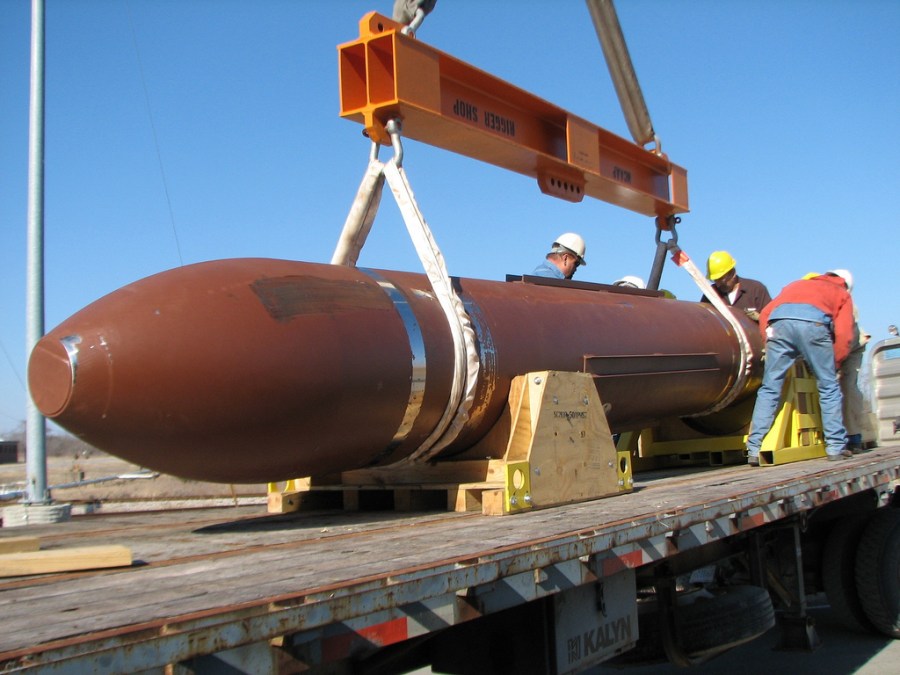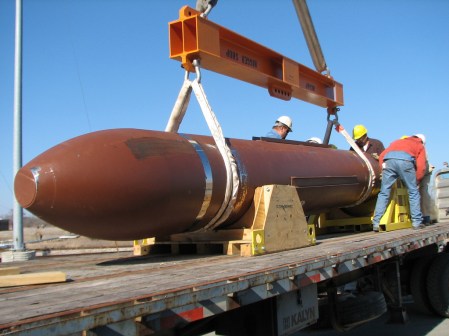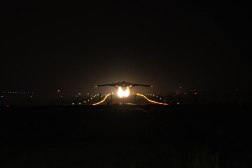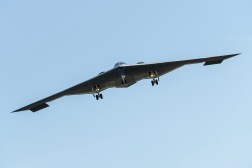Battle damage assessment from Iran strikes could lead to improvements in MOP bomb technology

Information gleaned from the intelligence community’s assessment of the effects of recent American military strikes on Iran’s nuclear facilities will help inform future versions of weapons like the Massive Ordnance Penetrator, according to a senior defense official.
The 30,000-pound GBU-57, also known as the MOP, played a key role in Operation Midnight Hammer last month. Air Force B-2 stealth bombers dropped 12 MOP bombs on two different ventilation shafts at Fordow. Another two were used against the Natanz site.
The technology is designed to be capable of attacking underground targets. It can reportedly hit locations hundreds of feet below ground level.
“MOP is a large, GPS-guided, penetrating weapon with the ability to attack deeply-buried and hardened bunkers and tunnels. The warhead case is made from a special high‑performance steel alloy and its design allows for a large explosive payload while maintaining the integrity of the penetrator case during impact,” according to an Air Force description of the system.
The Defense Threat Reduction Agency was heavily involved in testing, modeling and simulation of the system for many years prior to Midnight Hammer, in partnership with the Air Force.
“What we do try to do is test [technologies] in what we call a ‘threat representative environment.’ And in this case, we built a test site to test the munitions against, in collaboration with the Air Force and DTRA’s test organization, to try to ascertain the effects that the MOP would have in certain environments. We’ve continued to do tests over time to then determine what those effects are, and then we use that information to support our modeling and simulation programs. Those models that we’ve built include the weapons effects that we saw during all of the testing events, and include a number of other factors that our experts have brought to bear. That model is also part of that targeting and weaponeering support that we talked about [with regard to Midnight Hammer]. So in addition to the threat representative testing that we did, where we were able to see how does the MOP act in certain situations and certain geographies and architectures, if you will, we also then use that information to support our further modeling and simulation to lead to our best targeting analysis to support those decision makers,” a senior defense official told reporters Thursday during a background call.
U.S. intelligence agencies are still working to complete a final battle damage assessment to better understand the impact of last month’s strikes on Iran’s nuclear sites.
“We don’t conduct the BDA here, but we eagerly anticipate the intelligence community completing BDA on this so that we can assess the models vice what actually happened according to their analysis, and then take a look at how accurate the projections were, so we can use information there to improve our modeling output and our targeting decision support packages that we put together. We also will be able to assess whether or not the weapon performed as planned, according to the BDA,” the senior defense official said.
“Then that information may go into future iterations of the technology,” they added. “We will take this information and determine did things work the way that we wanted them to, in which case, how can we continue to improve upon it? Or did things not work exactly as planned, and how can we fix that so that in the future our next-generation capabilities work that much better? We don’t have that information yet, but we look forward to receiving it so that it can inform our next investments in this arena.”
Notably, MOP fuzes can be programmed.
The bomb is “comprised of steel, explosive and a fuze, programmed bespokely [for] each weapon to achieve a particular effect inside the target. Each weapon had a unique desired impact, angle, arrival, final heading and a fuze setting. The fuze is effectively what tells the bomb when to function. A longer delay in a fuze, the deeper the weapon will penetrate and drive into the target,” Chairman of the Joint Chiefs of Staff Gen. Dan Caine told reporters last month during a press briefing about Midnight Hammer.
The Air Force is pursuing a MOP modification program to integrate a “smart fuze” capability into the weapon. The so-called Large Penetrator Smart Fuze is intended to provide “increased probability of kill” against hard and deeply buried targets “by mitigating the risk of target intelligence uncertainty,” according to a report from the Pentagon’s director of operational test and evaluation.
On Thursday’s call, the senior defense official declined to say whether the MOPs used in Midnight Hammer were equipped with the smart fuze capability.






